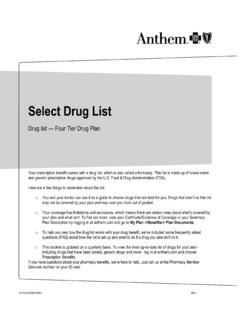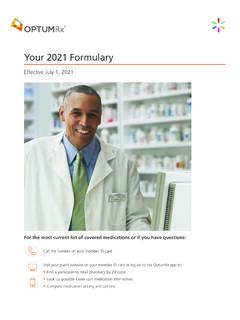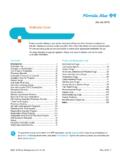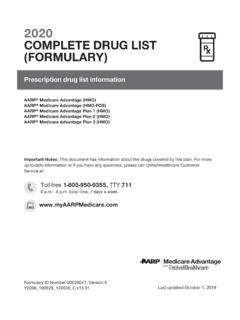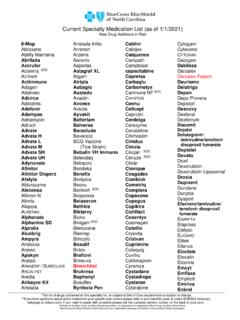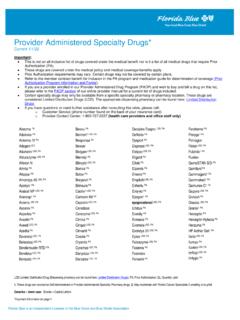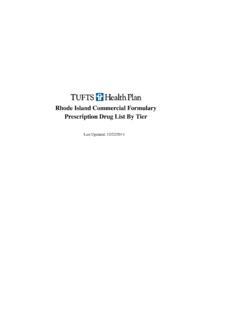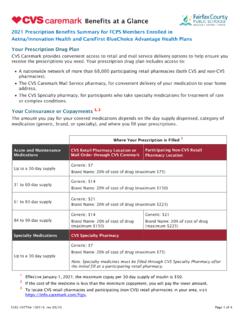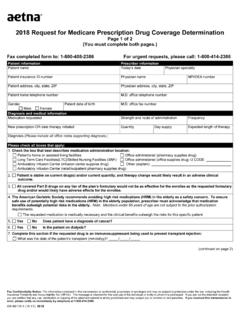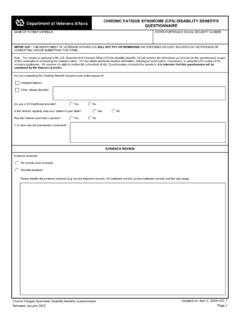Transcription of Select Drug List
1 Select Drug List Drug list Four Tier Drug Plan Your prescription benefit comes with a drug list, which is also called a formulary. This list is made up of brand-name and generic prescription drugs approved by the Food & Drug Administration (FDA). Here are a few things to remember about the list: o You and your doctor can use it as a guide to choose drugs that are best for you. Drugs that aren't on this list may not be covered by your plan and may cost you more out of pocket. o Your coverage has limitations and exclusions, which means there are certain rules about what's covered by your plan and what isn't. To find out more, view your Certificate/Evidence of Coverage or your Summary Plan Description by logging in at and go to My Plan ->Benefits-> Plan Documents. o To help you see how the drug list works with your drug benefit, we've included some frequently asked questions (FAQ) about how the list is set up and what to do if a drug you take isn't on it.
2 O This booklet is updated on a quarterly basis. To view the most up-to-date list of drugs for your plan - including drugs that have been added, generic drugs and more - log in at and choose Prescription Benefits. If you have questions about your pharmacy benefits, we're here to help. Just call us at the Pharmacy Member Services number on your ID card. 05267 GAMENABS IND. Select Drug List What is a drug list? The drug list, also called a formulary, is a list of prescription medicines your plan covers. It includes hundreds of brand-name and generic drugs approved by the Food & Drug Administration (FDA). Is this a complete listing of all covered drugs? Yes, this is a complete listing of all the drugs on the drug list. But, it's possible a drug(s) on this list may not be covered, depending on your plan's design. Your coverage has limitations and exclusions, which means there are certain conditions that determine what's covered by your plan and what isn't.
3 To find out more, read your Certificate/Evidence of Coverage or your Summary Plan Description, which you got when you signed up for your plan. How can I find a drug on the list? The drugs are listed in alphabetical order based on the name of their drug class, also called therapeutic class. You can search the PDF drug list by: o Drug name, using Ctrl + F on your keyboard, then type in the name of the drug you're looking for. o Drug class, using the categories listed in alphabetical order. The Notes column will tell you if you need preapproval before you can take the drug (called prior authorization or PA), or if you need to try other drugs first for your treatment (called step therapy or ST). When I search the list, I see that each drug is on a tier. What are the tiers for? The drug list is set up in tiers or levels. We place drugs on different tiers based on how well they work to improve health, whether there are over-the-counter (OTC) options and their costs compared to other drugs used for the same type of treatment.
4 Your share of the drug cost will depend on what tier a drug is on. The lower the tier, the lower your share of the cost. Here's a breakdown of the tiers in your plan: o Tier 1 drugs have the lowest cost share for you. These are usually generic drugs that offer the best value compared to other drugs that treat the same conditions. o Tier 2 drugs have a higher cost share than Tier 1. They may be preferred brand drugs, based on how well they work and their cost compared to other drugs used for the same type of treatment. Some are generic drugs that may cost more because they're newer to the market. o Tier 3 drugs have a higher cost share. They often include non-preferred brand and generic drugs. They may cost more than drugs on lower tiers that are used to treat the same condition. Tier 3 may also include drugs that were recently approved by the FDA. o Tier 4 drugs have the highest cost share and usually include specialty brand and generic drugs. They may cost more than drugs on lower tiers that are used to treat the same condition.
5 Tier 4 may also include drugs recently approved by the FDA or specialty drugs used to treat serious, long-term health conditions and that may need special handling. How will I know how much my drug will cost? You can go online and with the Price a Medication Tool, get pharmacy-specific pricing from a number of local retail pharmacies in your zip code. If my medicine isn't on the drug list, what are my options? Here are a few things to think about: o If you want to take a drug that's not on the drug list, you may have to pay the full cost for it. o You can also talk to your doctor or pharmacist to see if there's another drug covered by your plan that will work just as well, or if generic or OTC drugs are an option. Only you and your doctor can decide what drugs are right for you. o You can search for generic drugs at OTC drugs aren't shown on the list. o If a drug you're taking isn't covered, your doctor can ask us to review the coverage. This process is called preapproval or prior authorization.
6 Your doctor can get the process started by calling the Pharmacy Member Services number on the back of your member ID card or by downloading a prior authorization form from our website and submitting it. If your request is approved, the amount you pay for the drug will depend on your plan's benefit. Who decides what drugs are on the list? The drugs on the list are reviewed through our Pharmacy and Therapeutics (P&T) process. In this process, a group of independent doctors, pharmacists and other health care professionals decides which drugs we include on our lists . This group meets regularly to look at new and existing drugs and recommends drugs based on how safe they are, how well they work and the value they offer our members. What's the difference between brand-name and generic drugs? A brand-name drug is FDA-approved and usually available from only one manufacturer. It may be protected by a patent, which means it can only be made or sold by the company that has the patent.
7 A generic drug is also FDA-approved and has the same active ingredients as the brand-name drug. But a generic drug is usually available only after the patent on the brand-name drug ends. It may look different, but a generic drug works the same as the brand-name drug. Online Pharmacy Resources Find your closest network pharmacy, get the most up-to-date coverage information on your drug list including details about pricing your medication, brands and generics, dosage/strength options, and much more when you log in at Does the drug list change, and how will I know if it does? Drugs on our list are reviewed on a regular basis. Sometimes, drugs are added, removed or moved to a different tier. We'll let you know if a drug you take is taken off the list and, in some cases, if a drug you take is moved to a higher tier. You can always check the drug list to make sure medicines you take are still on it. You'll find the most up-to-date drug list when you log in at Does my plan cover preventive drugs?
8 We cover preventive care drugs with zero cost share in compliance with the Affordable Care Act (ACA). A note about opioid analgesics. The member cost share for certain abuse-deterrent opioid analgesics may be lower in some states because of laws in those states. Opioid analgesics are a type of painkiller. In response to the global opioid epidemic, the Food and Drug Administration (FDA) has encouraged drug manufacturers to develop opioids with properties that help deter their misuse and abuse. Drug(s) may be excluded from the list based on your plan's benefit design. KEY. Here are some terms and notes you'll find on the drug list. Brand name drugs are in UPPER CASE, bold type. Generic drugs are in lower case, plain type. $0 = preventive drugs. For some members, this product may be covered at 100% with $0 cost share with a prescription from your provider if specified criteria are met. DO = dose optimization. Usually, this means you may have to switch from taking a drug twice a day to taking it once a day at a higher strength.
9 LD = limited distribution. These drugs are available only through certain pharmacies or wholesalers, depending on what the manufacturer decides. PA = prior authorization. You may need to get benefits approved before certain prescriptions can be filled. QL = quantity limits. There are limits on the amount of medicine covered within a certain amount of time. SP = specialty drugs. Specialty drugs are used to treat difficult, long -term conditions. You may need to get this drug through a specialty pharmacy. ST = step therapy. You may need to use another recommended drug first before a prescribed drug is covered. 2022 Georgia Select Drug List Table of Contents *ADHD/ANTI-NARCOLEPSY/ANTI-OBESITY/ANORE XIANTS* .. 7. *ALLERGENIC EXTRACTS/BIOLOGICALS MISC* ..8. *AMINOGLYCOSIDES* .. 8. *ANALGESICS - ANTI-INFLAMMATORY*.. 8. *ANALGESICS - NONNARCOTIC* ..10. *ANALGESICS - OPIOID*.. 11. *ANDROGENS-ANABOLIC* .. 12. *ANORECTAL AND RELATED PRODUCTS* .. 13. *ANTHELMINTICS*.
10 13. *ANTIANGINAL AGENTS*..13. *ANTIANXIETY AGENTS*.. 14. *ANTIARRHYTHMICS* .. 14. *ANTIASTHMATIC AND BRONCHODILATOR AGENTS*..14. *ANTICOAGULANTS* ..16. *ANTICONVULSANTS* ..17. *ANTIDEPRESSANTS* .. 18. *ANTIDIABETICS*..20. *ANTIDIARRHEAL/PROBIOTIC AGENTS* .. 23. *ANTIDOTES AND SPECIFIC ANTAGONISTS* .. 23. *ANTIEMETICS*.. 23. *ANTIFUNGALS* ..23. *ANTIHISTAMINES*.. 24. *ANTIHYPERLIPIDEMICS*.. 24. *ANTIHYPERTENSIVES* .. 25. *ANTI-INFECTIVE AGENTS - MISC.*.. 27. *ANTIMALARIALS* .. 28. *ANTIMYASTHENIC/CHOLINERGIC AGENTS* .. 28. *ANTIMYCOBACTERIAL AGENTS* ..28. *ANTINEOPLASTICS AND ADJUNCTIVE THERAPIES* .. 28. *ANTIPARKINSON AND RELATED THERAPY AGENTS* ..31. *ANTIPSYCHOTICS/ANTIMANIC AGENTS* ..32. *ANTIVIRALS*.. 34. *BETA BLOCKERS*.. 36. *CALCIUM CHANNEL BLOCKERS* .. 37. *CARDIOTONICS*..38. *CARDIOVASCULAR AGENTS - MISC.* .. 38. *CEPHALOSPORINS* ..39. *CONTRACEPTIVES*.. 39. *CORTICOSTEROIDS*.. 44. *COUGH/COLD/ALLERGY* ..45. *DERMATOLOGICALS* ..46. *DIAGNOSTIC PRODUCTS*.







